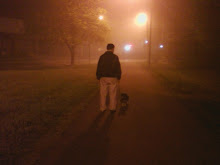Sermon preached Easter Sunday, April 4, 2010
Text: Luke 24:1-12
There are a number of people who have been here a long time this morning and I really appreciate them all – those who worked with the breakfast, musicians, others. Thank you. Some have already heard the sermon I am about to preach, though they are never exactly the same twice. Still, I thought a small 11 a.m. bonus was in order – no I am not cutting five minutes! A group of salesmen went to the funeral of one of their colleagues. As a few of them went to view the body, they couldn’t help but notice that their friend did not look good. “Gosh, he looks just terrible,” one of them finally admitted. “What did he have?” To which another replied, “North Dakota, South Dakota, western Minnesota…” (Pretty Good Joke Book, 4th ed. 99)
One Easter morning, a Sunday School teacher asked her class if they knew the origins of this special day. One young man responded immediately, “It’s opening day for the Yankees and the Mets!” Not wishing to stifle creative thinking, the teacher responded, “Yes, that is correct! But I had something else in mind.” A young girl then stood and remarked, “This is the day we get nice new clothes and go find the eggs from the Easter Bunny.” “That’s right,” said the teacher, “but there’s something else just a little more important.” A young man then jumped up and yelled, “I know, I know! After Jesus died on the cross, some of his friends buried him in a tomb they called a sepulcher.” The teacher thought, “I don’t believe it, someone actually knows.” The little boy continued, “And three days later Jesus arose and opened the door of his tomb and stepped out.” “Yes, yes,” said the teacher, “go on, go on!” And the youngster said, “And if he sees his shadow, we have six more weeks of winter.” (A Minister, a Priest, and a Rabbi, 46-47)
This is a silly story, and, in some ways, an idle tale. “Idle tale” that was the first reaction of those who heard the story of the resurrection. How could this be? Jesus died a cruel, gruesome death at the hands of the Roman authorities. How is it possible that he lives? Yet, over time, each came to know the reality of that morning. The testimony of the women became a reality for them. Each disciple experienced the Jesus they had known as wise teacher, healing presence, visionary leader, each experienced him as alive. It amazed them. It changed them forever. Their life-changing relationship with Jesus continued.
How can this be? How is it possible to get from despair to hope, from fear to courage? How is it possible to go through death to new life? The Easter story, the story of Jesus’ resurrection, does not resolve all the mysteries about what happened, nor answer all the questions we may have, but this much it does say – it is possible to get from despair to hope. It is possible to move from fear to courage. Easter offers testimony that new life is possible on the other side of death. The Easter story is a story that takes a sad song, and makes it better.
How can this be? It just is. The testimony of the resurrection is that the God of Jesus Christ is a God who does this, who influences the world in this way. The God of Jesus Christ specializes in new life. The God of Jesus Christ speaks a clear “yes” to life, to love, to compassion, in the resurrection. The God of Jesus Christ is an artist who works wonders when it comes to taking sad songs and making them better. The presence of this God in our lives has become the continuing presence of Jesus in our lives, and the presence of Jesus in our lives is a resurrection presence.
This story is not an idle tale to us, not simply because we read it from a work called “The Gospel According to Luke.” This story is not an idle tale to us because we, too, can testify that resurrection happens. We have stories to tell about the tenacity of hope, about the strength of love, about the possibilities for new life when all seemed to be dead or dying. We, too, have experienced God’s presence, the presence of Jesus in our lives as healing, hopeful, encouraging, love-inspiring and life-giving.
Last week, a few of us gathered together to watch the film The Visitor for our faith and film night. It is the story about a university professor named Walter whose life is a sort of living death. He tells his colleagues he is working on a book when he has done virtually nothing. He has been teaching the same course for twenty years, and now just changes the dates on the syllabus. His wife’s death in the recent past has left him empty. She was a gifted pianist, but his own attempts to learn the piano are fruitless. He seems to have no gift for music.
On a trip to New York, where he has an apartment he has not been in in a long time, Walter discovers that another couple has moved in, swindled by someone who rented the place to them. Tarek is a musician from Syria, a drummer. His girlfriend, Zainab is from Senegal, and makes and sells jewelry. An unlikely friendship develops. Tarek begins to teach Walter the drums – and he finds his gift for music. Literally and metaphorically, he is living life in a new rhythm. It is life rather than a walking death. When Tarek is picked up for a minor charge in the subway, Walter discovers that Tarek and Zainab are in the country illegally, but his caring for them doesn’t end. He has found life. He has rediscovered connection with the world. A sad song has been made better.
This is a story about resurrection. It is a story about the kind of thing God does in people’s lives. While it is only a movie, it connects with people at a deep level because we know this story. Perhaps it has been ours – life drifts. We lose touch with others and with ourselves. We go through the motions. But new life is always possible. Resurrection can happen, and happens. This is not an idle tale.
In his recent book, Made for Goodness, written with his daughter Mpho, Archbishop Desmond Tutu and Mpho share the story of Natalie. Natalie sits in an orphanage in Rwanda cuddling a small child to her breast. Natalie is a Tutsi woman. Her family was massacred by a Hutu mob in the genocide. The child she is holding is not her own. It is a Hutu child. Who knows if the child’s parents are dead or if they have been imprisoned for their part in the slaughter? Perhaps this is the child of one of those responsible for the death of Natalie’s family. No matter; Natalie says she is grateful to be alive. This person in her lap is alive and in need of comfort. This small act of love is Natalie’s act of hope. A hug is an ordinary gesture. It is repeated around the world a million times a day. Natalie’s hug offers a testimony. The ordinary gift of a cuddle stands as witness to goodness. The child’s goodness has not been erased by her people’s deeds. Natalie’s goodness allows her to see, in the face of one who might be considered an enemy, a child who is a good gift from the good God. (34-35)
When surrounded by death, as were so many in Rwanda, as are too many in places near and far, we can succumb to a kind of death in life. Caring can become too painful, too risky. Trying to make the world a little better can seem pointless. Sad songs can seem permanently etched in the playlist of our hearts. But resurrection happens. It is not an idle tale. The Natalies of the world remind us that caring is possible even in the most tragic circumstances. Small acts of love are acts of resurrection hope. Sad songs can be made better.
Richard Lischer, a professor of preaching at Duke Divinity School, once shared this story in a sermon. Our friend had already done two full courses of chemotherapy and through it all had somehow managed to complete a doctoral dissertation at the University of Virginia. To celebrate she and her husband rented a VFW hall, hired a band, and threw one of the biggest parties I’ve ever seed for the whole church and half the community. Two days before graduation her doctors confirmed that the cancer was back. The experimental treatments would begin the day after graduation. Only a few of us knew it, and my guess is we would have limped through the ceremony and cancelled the party. But she had the party. And I tell you I have never heard the gospel of God’s “Yes” preached more powerfully than I saw it danced on the floor of the VFW. An outsider would have seen only the vintage 1960’s arthritic gyrations that we were all doing, but this was a woman of faith and she danced her Yes in the grip of the No. And that’s the way we do it. The best celebrating is done in the face of the enemy, the best dancing on the devil’s dance floor. You can’t always separate the Yes from the No but at least one person has done it definitively. Because of the resurrection of Jesus, we trust that there is this distinction, and that it holds true for us. (Richard Lischer, sermon on II Corinthians 1:15-22, privately printed found on line)
Life throws us plenty of Nos, and there are fewer bigger Nos than tragic, untimely deaths – deaths like Jesus’. The resurrection is about God’s “Yes” – yes to life, yes to love, yes to hope, yes to dreams, yes to dancing, yes to taking sad songs and making them better. The resurrection is not an idle tale because it happens - - - and we will witness it when we open our eyes, our ears, our hearts, our mind, our souls. The resurrection is not an idle tale because it changes the way we live.
Ku Sang was a Korean poet and journalist who lived from 1919-2004. Ku experienced the ups and downs of his nation in the twentieth century, having had to flee from North to South after the liberation of Korea in 1945 and developments which followed in the North. Before that, he had suffered a significant crisis of faith while studying in Japan. Yet Ku could compose a poem which captures some of the life-changing power of the resurrection. Here are a few lines from his poem, “Easter Hymn.”
Since there is your Resurrection and ours,
Truth exists;
since there is your Resurrection and ours,
Justice triumphs;
since there is your Resurrection and ours,
suffering accepted has value;
since there is your Resurrection and ours,
our faith, hope love, are not in vain;
since there is your Resurrection and ours,
our lives are not an empty abyss.
Because God is this kind of God, because Jesus is resurrection, we live the way of love. We live with courage. We live with joy. We live with hope. We live with compassion. We live in ways that give life. We live in new rhythms.
Resurrection is no idle tale. It is a sad song made better and by God’s grace it happens all the time. We are invited to join the party, to sing new songs, to dance to new rhythms. Amen.
Subscribe to:
Post Comments (Atom)


No comments:
Post a Comment